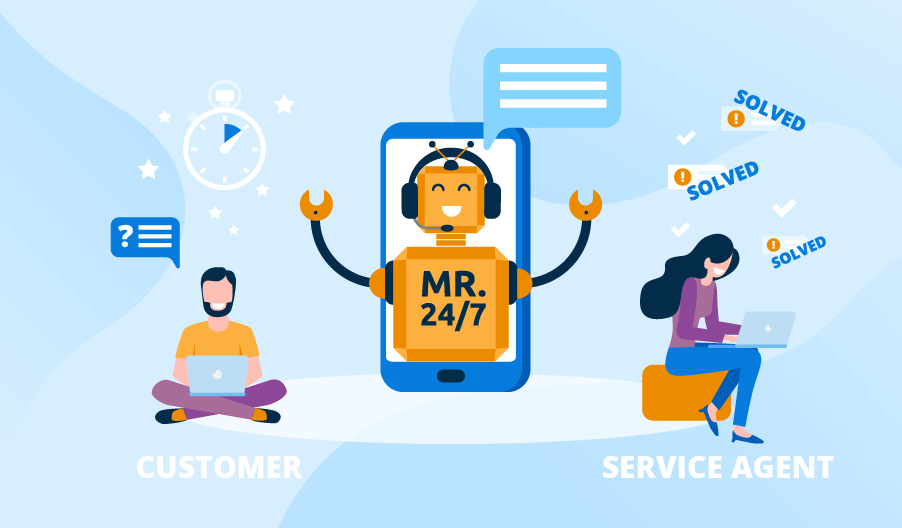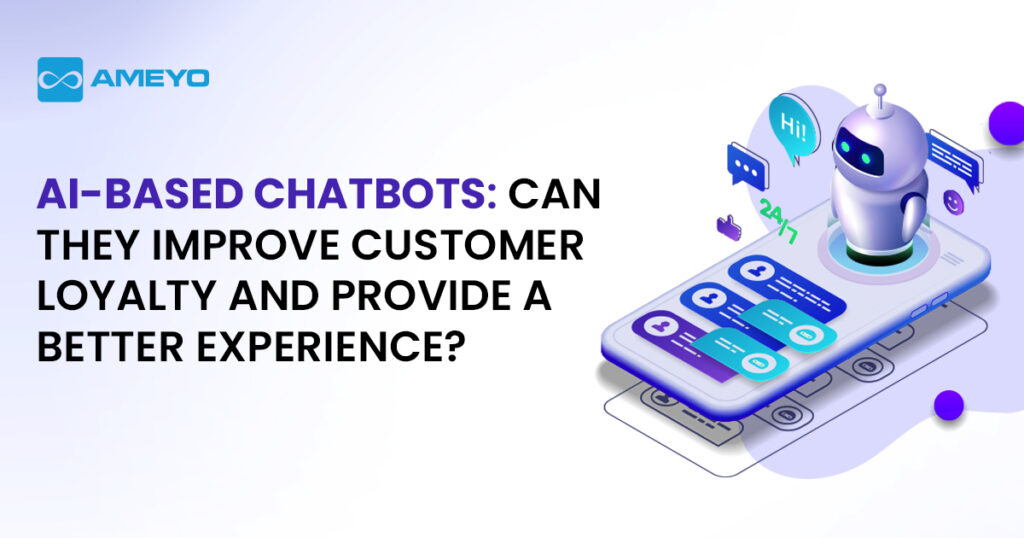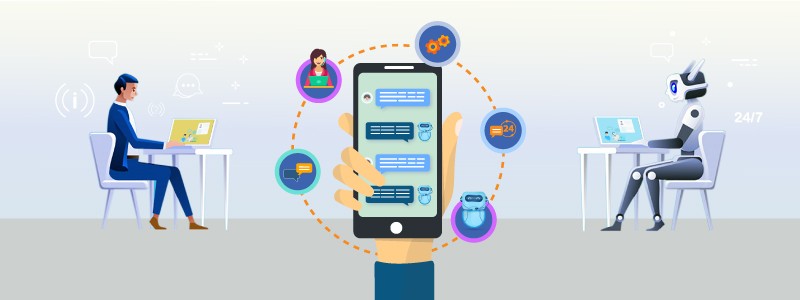Introduction to AI and Chatbots
In this digitally-driven world, the adaptation of Artificial Intelligence (AI) has been at the propensity of many industries, particularly within online businesses. Most business owners depend heavily on AI to either automate or streamline their services. Innovation and digitization have played a massive role in the advent of AI, but the widespread application of AI into customer interaction has transformed the customer-business landscape. As such, I’ll be taking a deep dive into AI and how chatbots can amplify the online customer experience.
Understanding artificial intelligence
Artificial Intelligence is an idea that encompasses a broad range of elements. AI is used in systems and processes that can carry out tasks human-like tasks. It’s integral in machine learning as it enables devices and applications to function with some semblance of human intelligence. It’s a technology that has complemented our digital transition.
AI is a consistent learning process; it learns from the patterns and behaviors of humans, thereby adapting to user behavior for an improved personalized experience. In essence, AI strives to make the interaction between human and machine more natural and productive.
The role of chatbots in digitization
Now the question is, where do chatbots come into the picture? Chatbots are AI-driven services designed to converse with customers directly. They are digital assistants, always available to lend a helping hand and answer queries, all at a customer’s convenience. They help generate leads, promote products and services, and they provide personalized customer service. Their use in online businesses has been growing over the years because they come at a fraction of the cost of human personnel while delivering impeccable service around the clock.
The seamless integration of chatbots into a company’s website or social media platform enhances customer engagement quite significantly. With a deeper understanding of AI and the importance of chatbots, it’s clear to see how crucial they are to the evolution of customer interaction in the digitally-powered business world.

This image is property of chatlayer.ai.
AI Powered Chatbots
The rise of artificial intelligence (AI) has opened up new doors in customer service, including the use of AI-powered chatbots. These intuitive tools not only revolutionize the way businesses interact with their customers but also provide a cost-effective solution for handling customer inquiries and improving the overall customer experience.
Working Mechanism of AI Chatbots
AI chatbots work on the principles of machine learning and natural language processing (NLP). This empowers them to understand and interact in human language. The bots “learn” from previous interactions, becoming more knowledgeable and efficient in providing relevant responses.
Variation of Complexity in AI Chatbots
AI chatbots vary in complexity. Some bots are simple scripted tools that answer questions based on a set script, while others are more advanced, utilizing machine learning to have sophisticated conversations with the users. Depending on the need, businesses can either opt for basic bots or decide to invest in a more sophisticated version for their customer service.
Integrating AI Technologies into Chatbots
Integration of AI technologies into chatbots is another exciting development. With this, the chatbots can understand user’s actions, identify patterns, and predict future behaviours. They can also handle more complex tasks, such as personalizing responses and offering product recommendations.
In essence, AI chatbots can transform customer interaction, making it more personalized and efficient. They are the perfect tool for businesses to improve engagement, increase customer satisfaction, and drive revenue growth. And as AI continues to evolve, the potential of chatbots in enhancing customer interaction will only amplify.

This image is property of www.scnsoft.com.
Benefits of Chatbots in Customer Service
I’ve been observing an intriguing development in the world of AI, particularly in its application to customer interaction. Chatbots have firmly established themselves as game-changers in online businesses. They’ve grown to become highly reliable digital assistants that greatly aid in enhancing the quality of customer interaction. But what exact benefits do they offer? Let’s delve into this matter.
Improving customer engagement
Chatbots have proven to be instrumental in keeping customers engaged. Gone are the days when websites were only informational. Today’s tech-savvy customers demand interaction. A chatbot on your website means customers can interact with your business anytime they want, even outside of usual office hours. This constant availability fuels better engagement and builds stronger relationships.
Providing instant responses
One exceptional quality of chatbots is the ability to provide instant answers to customer inquiries. Customers no longer need to wait for office hours to get answers. A chatbot can respond to their queries, concerns, or complaints immediately, at any time of the day or night. This swift response time not only satisfies customers but increases the likelihood of them making a purchase.
Handling multiple customer queries simultaneously
Finally, chatbots can handle several customer questions at once. That’s a feat even the most experienced customer service representative might struggle with. No matter how many visitors your website gets, a chatbot can handle their myriad inquiries all at once, without getting overwhelmed. This level of efficiency ensures a smooth user experience on your website.
All in all, chatbots provide a plethora of benefits in customer interaction. By improving engagement, providing instant responses, and effortlessly handling multiple queries, they’ve truly become indispensable in the realm of AI customer service.

This image is property of www.ameyo.com.
Chatbots and Personalized Customer Experience
Let me tell you, chatbots are fast becoming an indispensable tool for customer interactions in business. By leveraging artificial intelligence (AI), they’re literally revolutionising the way we interact with customers, particularly online.
Tailoring Customer Interactions
No two customers are alike. They have different needs, preferences, and require unique approaches. That’s where chatbots, with their AI-powered capabilities, come into play. They can help provide personalized interactions by deploying conversational strategies based on customer behavior and preferences. No wonder we often say that AI chatbots are not just smart, they’re empathetic.
Personalized interactions go a long way in improving customer relationships, effectively resulting in increased engagement and higher conversions. This is why businesses are increasingly investing in chatbot technology. They understand that a one-size-fits-all approach just doesn’t cut it anymore.
Tracking User Interactions and Preferences
Imagine a salesperson who remembers every detail of every conversation you’ve had. That’s what an AI chatbot does. It can store and recall enormous amounts of data, allowing it to track user interactions and remember their preferences. This insane capacity for memory takes customization to a whole new level. Every subsequent interaction with customers is relevant and based on previous engagements. This helps foster increased rapport and loyalty among customers.
Enhancing Product Recommendations
Believe me when I say that the product recommendation feature of an AI chatbot is a game-changer. The ability to analyze customers’ past purchases, browsing history, and preferences to recommend products that they’re likely to purchase significantly enhances the shopping experience. It’s like having a personal stylist or an expert advisor at your fingertips. Plus, from a business perspective, it aids upselling and cross-selling efforts and boosts revenue.
So, you see, chatbots play a critical role in enhancing AI customer interaction. They provide personalized experiences and tailor interaction based on user preferences. This, in turn, boosts customer satisfaction, loyalty, and ultimately, your bottom line!

This image is property of www.latentview.com.
The Role of AI in Customer Relationship Management
In today’s digital world, solidifying connections with customers can be quite a task. However, AI has made this seemingly challenging task much convenient. They’re transforming the face of customer relations with their brilliance and efficiency.
Let’s delve deeper to understand better how AI is weaving its magic into CRM.
Integration of AI in CRM
The integration of AI in CRM is an interesting process that, I find, adds a layer of efficiency to business operations. AI simplifies CRM by automating repetitive tasks, thus freeing up more time for staff to focus on customer-oriented activities. AI bots analyze customer data to gain insights that help businesses understand customer needs better and tailor their services accordingly. AI in CRM is also instrumental in identifying sales opportunities and predicting future trends.
Improving Customer Interaction with AI
AI chatbots, a form of AI, are revolutionizing customer interactions. They are capable of understanding natural language, making conversations with customers more human-like. These chatbots provide instant responses to customer queries, ensuring customers get answers quickly. Chatbots can handle multiple interactions simultaneously, thereby improving overall customer engagement and interaction efficiency.
Maximizing Customer Satisfaction with AI
With the pressure of maintaining a high standard of customer satisfaction, AI comes to our rescue here as well. AI tools can monitor social media activity, identify common grievances or compliments, and inform businesses of these insights. This allows companies to respond to issues quickly, ensuring maximum customer satisfaction.
In the world we find ourselves in, where digital reactions are rapidly becoming the norm, integrating AI into CRM offers a ton of benefits. They help streamline processes, facilitate superior customer interactions, and ultimately, drive customer satisfaction to new heights.

This image is property of www.revechat.com.
Advancements of AI Chatbots in Ecommerce
With the continuous advancement of artificial intelligence (AI), businesses now have access to a plethora of tools that simplify and enhance customer interaction. One such tool that’s causing a significant shift in online businesses is the AI chatbot. These smart bots have emerged as key players in e-commerce platforms, enhancing the online shopping experience for customers and revolutionizing the way businesses operate.
Role in Buying Process
Chatbots play a crucial role in guiding a customer through the buying process. Due to the increasingly personalized nature of AI, chatbots can understand the customers’ needs and preferences, and can suggest tailored product recommendations. This not only increases the chances of a purchase but also makes a customer’s shopping journey much simpler and enjoyable.
Automation of Customer Support
Gone are the days when customers had to wait for hours to get a response from a customer support team. Thanks to AI chatbots, customers can get answers to their queries in real-time. By automating customer support, businesses can ensure that their customers’ concerns are addressed promptly, which in turn, improves customer satisfaction and loyalty.
Real-time Data Analysis for Decision-making
It’s not just customer interaction that gets a boost from AI chatbots. They also provide businesses with valuable insights through real-time data analysis. By observing customer interactions, chatbots can gather useful data sets that businesses can use to improve their decision-making process. Whether it’s understanding the market trend or improving product designs, real-time data analysis helps businesses stay ahead of the competition.
By integrating AI chatbots into their operation, businesses can enhance not only their customer interaction but also their overall business decision-making process. And as AI continues to evolve, we can expect to see even more impact of AI chatbots in the e-commerce industry.
Building an Effective AI Chatbot Strategy
Hello there! If you’re considering enhancing your customer interactions with artificial intelligence (AI), you’re definitely in the right place! Chatbots, powered by AI, provide a unique opportunity to connect with customers, respond to their queries, and provide top-of-the-line service around the clock. But, just slapping a bot onto your website won’t do the trick. To truly monetize AI in your online business and improve customer engagement, you need an effective chatbot strategy.
Determining the Purpose of the Chatbot
The first step in developing an effective AI chatbot strategy is determining what you want the bot to do. Do you want it to handle customer service queries, help customers make purchases, provide information about your products or services, or something else? Identifying your chatbot’s mission will guide its development and ensure it adds genuine value to your customer interactions.
Choosing the Right AI Technology
Next, you need to decide what kind of AI technology you want to use. There are basic chatbots that can handle simple tasks and queries. Then there are advanced AI bots capable of learning from customer interactions and improving their responses over time. Both come with their own sets of advantages and challenges. Your choice here should be aligned with your overall business goals and your budget.
Designing the Customer Interaction Flow
Finally, an essential part of your strategy should involve designing the customer interaction flow. This includes defining how the chatbot will interact with your customers, what type of queries it can handle, how it will respond to different scenarios, and how it can escalate complex issues to human agents. Remember, the goal should always be to provide an enriching and seamless customer experience.
So, there you go. Integrating AI chatbots into your customer interaction strategy isn’t just about implementing a new technology. It’s about strategically aligning your business goals with your customers’ needs – all with the help of AI. Exciting, isn’t it?
Strategies to Improve Customer Interaction with Chatbots
Expanding on the potential of Artificial Intelligence in online business, let’s dive deeper into the conversational aspect of AI, particularly the use of chatbots. The interactive relationship between customers and these virtual assistants plays an instrumental role in maintaining and enhancing customer experience, thus, inevitably affecting the business’s profitability.
Making Chatbots more Conversational
Making chatbots more conversational doesn’t simply mean polishing their linguistic capabilities. It extends to enhancing their ability to comprehend the intent behind a customer’s questions or complaints. Instead of merely responding with generic pre-populated replies, chatbots need to be configured to dive deeper into the customer’s sentiments. The ability of the chatbots to understand and reciprocate human emotions such as empathy, encouragement, and assurance portends a more satisfying customer interaction.
Adapting to User Needs and Expectations
In response to the ever-raising customer demands, businesses should work towards making their chatbots even more adaptable to the evolving user needs. This means not just answering the posed questions but more importantly, anticipating user queries and expectations. Further, they should consider user feedback and incorporate it into refining the bot’s interactions.
Continuous learning and Evolution of Chatbots
Lastly, it’s worth emphasizing that chatbots shouldn’t remain static. They need to continuously learn and evolve as they interact with different customers across various touch points. This could be achieved by integrating them with advanced deep learning algorithms and machine learning techniques, enabling them to gain valuable insights from every conversation they handle.
Empowering chatbot technology is not just about making them talk, but more about making them understand and empathize, in a constant effort of improvement and adaptation. Through this, the customer’s journey with your business becomes more seamless and enjoyable, ultimately capitalizing on AI’s enormous potential in driving online business revenue.
The Future of AI and chatbots in Customer Interaction
As we march into the digital era, I think it’s safe to say that the future of customer interaction lies greatly in the hands of Artificial Intelligence and chatbots. Businesses are continuously looking for ways to enhance AI customer interaction to improve customer service and engagement.
Predicted Developments in AI Technology
From my perspective, the future holds a lot of promise for AI technology. One development that stands out for me is Natural Language Processing (NLP). NLP is going to shape the future of AI, enabling chatbots to understand and interpret human language in a more natural and sophisticated manner. This means chatbots will be able to understand customer queries better, resulting in more accurate responses and ultimately, better customer service.
I also foresee an increase in multimodal interaction where chatbots will be able to interact with customers through various modes such as text, voice, and even visuals. This is definitely going to take AI customer interaction to a whole new level.
Potential Impacts on Customer Service and Engagement
I believe these developments in AI technology are going to transform customer service and engagement drastically. I expect to see more personalized customer service as AI gets better at analyzing customer behavior and predicting customer needs.
Talk about ’round the clock service’, chatbots have this covered! They’ll be able to provide 24/7 customer support, resolving customer issues instantly at any time of the day. Also, the fact that chatbots can handle multiple customer queries simultaneously means that customers won’t have to spend time waiting in queues.
In the long run, I envisage a rise in customer satisfaction levels and an increase in customer loyalty. All in all, enhancing AI customer interaction with chatbots is shaping up to be a game changer in the world of online business.
Enhancing AI Customer Interaction with Chatbots
In the competitive world of e-commerce and online business, it’s clear that I need to stay ahead of the curve to boost my customer service. It’s here that Artificial Intelligence (AI) and especially the use of AI chatbots come in handy. But implementing AI chatbots in my business isn’t a walk in the park, I face challenges and issues that need addressing for smooth customer interaction through chatbots.
Potential issues and problems faced
Like anything else, embarking on the AI chatbot journey isn’t always smooth sailing. Technical hiccups, like bot understanding and response accuracy, can be a significant deterrent. The unpredictability of customer queries and the dynamic business landscape require the bot to be frequently updated, making the exercise time intense.
Moreover, the unnatural and robotic conversations stemming from a lack of contextual understanding and emotional intelligence might turn my customers off. What’s more, there are valid concerns related to data security as well. AI needs a massive amount of data to learn and predict customer behavior accurately. However, it raises issues around data privacy and protection.
Practical solutions and improved strategies
Fortunately, ongoing advancements in AI are churning out solutions to these challenges. Deep learning algorithms can be deployed to improve the bot’s understanding of human language, grasp context, and generate better response accuracy. Emotional AI can be integrated into chatbots to create more human-like interactions to improve the user experience.
Also, a cross-functional team consisting of professionals from data science, devOps, and legal should be set up to address data privacy and protection issues. They should conduct security audits, implement robust data anonymization and encryption protocols, and instill a culture of data protection throughout the organization.
In a nutshell, by overcoming these challenges through feasible solutions, I can make my chatbots more human-like, efficient, and safe, eventually boosting my customer interaction and consequently, my business. The current digital era demands a revolutionized mode of communication for businesses. But how? The answer is through the use of AI chatbots. These bots serve as the ultimate solution to offer impeccable and timely customer service while cutting down operational costs.
Case Studies of Successful AI Chatbot Implementation
Review of successful corporate applications
As various organisations have significantly improved their customer interaction through AI chatbots, it’s worthwhile to review a few notable examples. For instance, ‘eBay’. They integrated an AI chatbot named ‘ShopBot’ on Facebook Messenger and managed to revolutionize their customer shopping experience. The bot understands the user’s purchasing behavior and offers personalized product recommendations, making the shopping process streamlined and convenient.
Similarly, ‘Amtrak’, the US rail service implemented AI chatbot to handle customer inquiries and assist in booking tickets. The results? An increase in bookings by 25% and saving over $1 million in customer service expenses.
Lessons learned and best practices
From reviewing successful implementations, there exists a few key insights and best practices to adopt for an effective AI chatbot strategy.
-
Make it user-centric: Your chatbot should be designed to understand your users’ needs and preferences. eBay’s ‘ShopBot’ was successful because it catered to individual needs rather than offering generic suggestions.
-
Simplicity wins: The main purpose of chatbots is to make processes simpler. Ensure the chatbot is easy to use and understand.
-
Focus on customer value: Amtrak’s case study emphasizes that the more value a chatbot offers customers, the more successful it will be. Hence, aim for maximum customer value.
Integrating AI chatbots can surely enhance your customer interaction. Make sure to learn from those who have found success, and craft strategies suiting your business needs. It will not only improve your relationship with your customers, but also lead your business towards success.
Conclusion: Monetizing AI Chatbots in Online Business
In our journey through the digital world, we’ve discovered that Artificial Intelligence and chatbots are not just tools of convenience, but powerful devices capable of revolutionizing customer interactions.
Revolutionizing customer interactions
Let me tell you, by leveraging the power of AI within chatbots, businesses can deliver personalized 24/7 customer service to each and every individual. This no longer confines customer service to business hours, making it much more efficient and bringing customer satisfaction to new heights.
Providing business value
Now, let’s talk about business value. The adaptability of AI Chatbots enables them to continuously learn and improve. This means they become increasingly accurate in interpreting and responding to customer inquiries. And we know that faster problem resolution equals happier customers, right? Well, happy customers mean repeat business and, consequently, increased revenue.
Moreover, the data collected through interactions with customers provides businesses with invaluable insights into their customer’s needs and behaviors. This could facilitate more effective marketing strategies and help businesses stay ahead of their competition. Honestly, the business value brought by AI chatbots is truly diverse, from customer service to data collection.
Setting up for future progress in AI
Looking forward, can you imagine the future progress in AI? I guarantee that it’s not just about drafting better responses or designing more human-like conversations. It’s about integrating AI across multiple platforms to create a seamless customer experience.
As you can see, whether it’s revolutionizing customer interactions, providing definitive business value, or laying the groundwork for future progress in AI, chatbots play a vital role. The way I see it, it’s time we embraced AI chatbots, monetized their potential, and charged ahead in this digital world.
